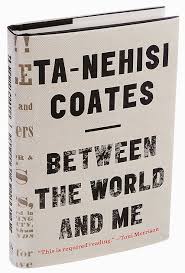Thoughts 1 Year After Ferguson
by Judy Helfand
As the Black Lives Matter movement continues to unfold, I’ve been thrashing about, asking myself what I should do, what I can do, what I want to do. Are #BlackLivesMatter leaders asking for particular support from white people? Does this apparent national upheaval require more from me than I’ve been doing all along to dismantle white supremacy? I feel on the margins of something amorphous that I cannot quite grasp.
 Then I picked up Between the World and Me by Ta-Nehisi Coates on the basis of a blurb from Toni Morrison on the back cover: “I’ve been wondering who might fill the intellectual void that plagued me after James Baldwin died. Clearly it is Ta-Nehisi Coates. The language of Between the World and Me, like Coates’s journey, is visceral, eloquent, and beautifully redemptive. And its examination of the hazards and hopes of black male life is as profound as it is revelatory. This is required reading.”
Then I picked up Between the World and Me by Ta-Nehisi Coates on the basis of a blurb from Toni Morrison on the back cover: “I’ve been wondering who might fill the intellectual void that plagued me after James Baldwin died. Clearly it is Ta-Nehisi Coates. The language of Between the World and Me, like Coates’s journey, is visceral, eloquent, and beautifully redemptive. And its examination of the hazards and hopes of black male life is as profound as it is revelatory. This is required reading.”
In this small book, I found a context for understanding my thrashing and uncertainty. The question Coates asks and explores in Between The World and Me is “how do I live free in this black body?” Coates writes as if addressing his son. He clearly lays out the history of the US as being built on the bodies of black people. And the people who think of themselves as white were formed from Jews, Irish, disparate groups who were washed white through a particular process and then their belief in being white elevated, not through, “wine tasting and ice cream socials, but rather through the pillaging of life, liberty, labor, and land; through the flaying of backs, the chaining of limbs, the strangling of dissidents, the destruction of families, the rape of mothers, the sale of children; and various other acts meant first and foremost to deny you [his son] and me the rights to govern our own bodies.” pg 8
 Those who think of themselves as white live in a dream, says Coates. “I have seen that dream all my life. It is perfect houses with nice lawns. It is Memorial Day cookouts, block associations and driveways. The Dream is treehouses and the Cub Scouts. The Dream smells like peppermint but tastes like strawberry shortcake. And for so long I have wanted to escape into the Dream, to fold my country over my head like a blanket. But this has never been an option because the Dream rests on our backs, the bedding made from out bodies.” (pg 11)
Those who think of themselves as white live in a dream, says Coates. “I have seen that dream all my life. It is perfect houses with nice lawns. It is Memorial Day cookouts, block associations and driveways. The Dream is treehouses and the Cub Scouts. The Dream smells like peppermint but tastes like strawberry shortcake. And for so long I have wanted to escape into the Dream, to fold my country over my head like a blanket. But this has never been an option because the Dream rests on our backs, the bedding made from out bodies.” (pg 11)
I am thrown back to what I know to be central to my work in creating a U.S. where black people live freely, where the racial categories black and white no longer exist. For Coates, the Dreamers, who have forgotten the terrible history of building wealth in this country, “would rather live white than live free.” He writes that for the Dreamers “Plunder has matured into habit and addiction; the people who could author the mechanized death of our ghettos, the mass rape of private prisons, then engineer their own forgetting, must inevitably plunder much more.” (pg 150) With increased technology, plunder now threatens the very earth, and ultimately, the Dreamers themselves.
Coates warns his son that he doesn’t believe they can stop the Dreamers—the Dreamers must stop themselves. “Do not pin your struggle on their conversion.” Although I do not consider myself a Dreamer, having abandoned the dream years back, I do see my responsibility in working with those who were taught to think of ourselves as white, who were raised in the Dream, and agree that, as Coates describes it, “the stage where they painted themselves white, is the deathbed of us all.” (pg 151)
To me this means that my work is to continue to unravel whiteness, following those white threads back through history, forward into ideas and plans we have for the future, deep into our own identities. This is a radical project that those of us taught to think of ourselves as “white” must carry into every social justice movement, into every institution, into family and community, into our lives with every conscious breath. This is how I am part of the #BlackLivesMatter movement.

Leave a Reply